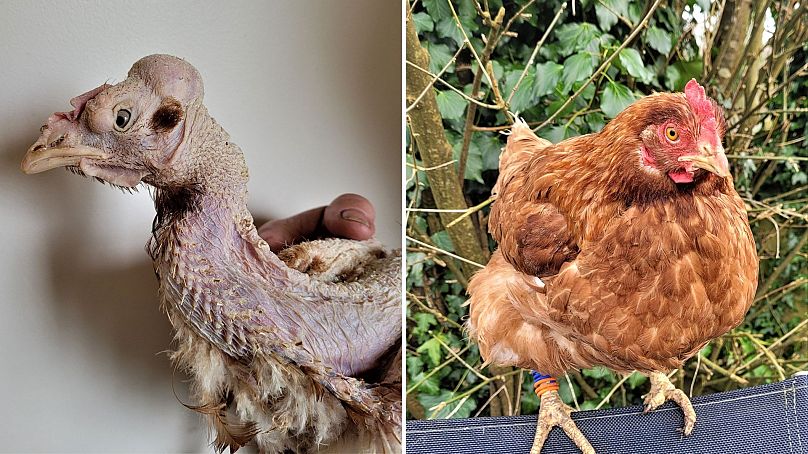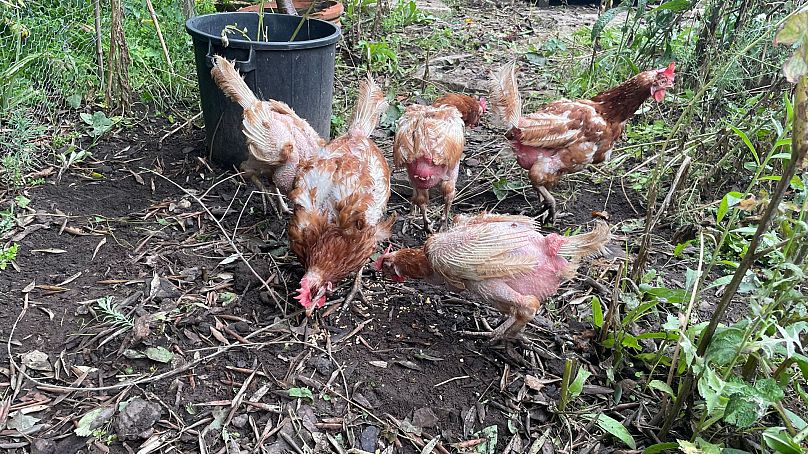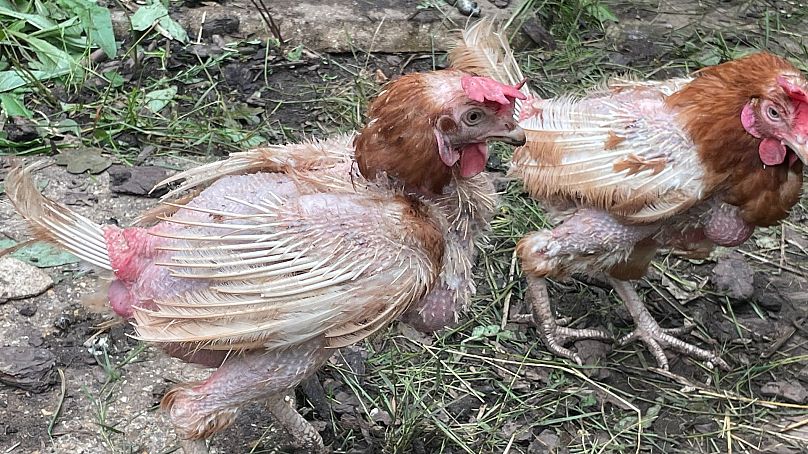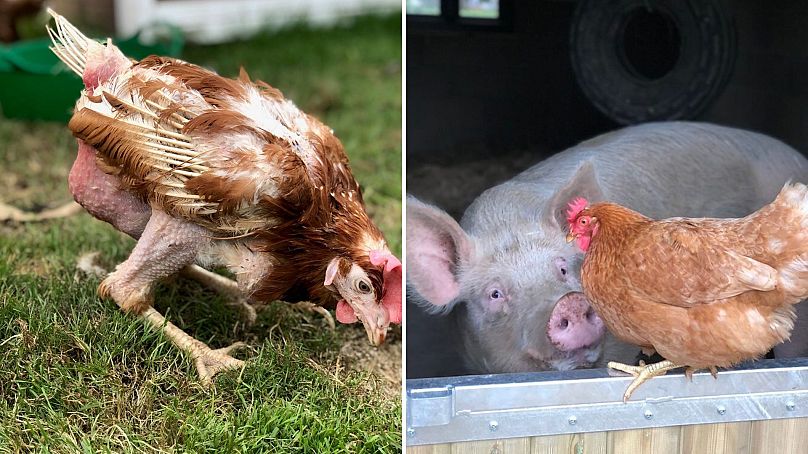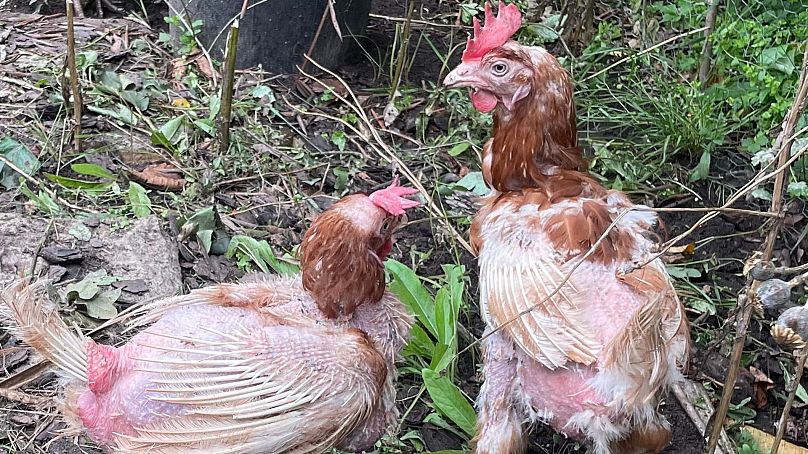Could your next pet be a chicken rescued from an egg farm?
Commercial hens start laying eggs when they are about four months old. By 18 months, their output declines and they are typically sent to slaughter.
Keen to rescue them from this fate and give them a better life, the British Hen Welfare Trust works to rehome chickens across the UK.
The charity started in 2005 with the modest goal of rehoming 100 hens. To date, it has rehomed nearly 1 million of them.
Here’s how it works and how you can contribute to a brighter future for Europe’s hens.
‘We’ve never stood on grass, we’ve never felt the sun on our backs’
The British Hen Welfare Trust (BHWT) started with a simple advert in a local newspaper: “We’ve never stood on grass, we’ve never felt the sun on our backs, we’d love a home. Can you help?”
The Devon-based charity now works with commercial egg farmers around the UK, who give up their hens once their laying capabilities start to decline.
“The farmers give us their hens to rehome because they want a nicer life for them - they want them to go on and have a free-range retirement,” explains Francesca Mapp, BHWT’s marketing consultant.
The alternative would usually be to send the hens to slaughter for pet food or low-grade meat products, as they are not the same breed of chicken typically used for human consumption.
The charity distributes rescued hens to 46 pop-up, volunteer-run rehoming points across the UK, with each bird travelling no more than one hour from its farm.
“They're such resilient little creatures,” Francesca tells Euronews Green.
“Once they're outside and they're in fresh air with sunshine on their backs, they start to flourish.”
Why rehome a commercial hen?
“What's brilliant about chickens is they're not just a pet. You actually get something in return,” says Julia Davies, an impact investor and environmental campaigner who rehomes commercial chickens.
“It’s a really great way of getting cruelty-free eggs.”
A flock of three or four hens (BHWT rehomes them in groups of three or more) will typically provide their new owner with “a couple of eggs a day for breakfast”, says Francesca.
Pet chickens will not only provide you with eggs, but they’ll also bring your garden to life.
“Chickens are the funniest, quirkiest, most characterful little creatures that you could imagine,” says Francesca. “I don't think they get enough credit for what amazing pets they make.”
She likens them to “cats and dogs with feathers - because you can literally pick them up and cuddle them…and they all have individual personalities.”
“I find them really funny - they are quite daft,” adds Julia. “And there's nothing nicer on a sunny day seeing them out in the garden making dust baths.”
Why do some rescue hens lack feathers?
BHWT rehomes caged, barn and free-range hens. Caged hens are most likely to lack feather coverage - both due to pecking from other birds and the heat in their enclosures.
Although tiny battery cages have been banned in the EU, caged chickens are still highly restricted, explains Dr Lizzie Rowe, an animal welfare specialist at Reading University, UK.
“They have little ability to perform behaviours they are highly motivated to perform, such as foraging and dustbathing,” she tells Euronews Green. This can lead to boredom and frustration, which often manifests itself in damaging behaviours such as feather pecking.
But “within a few months [of being rehomed], their feathers will come back and they'll look like show birds again,” says Francesca.
“I've had chickens that look like they've been plucked,” says Julia. “But after a couple of months, you have beautiful, healthy, fully feathered hens.”
Over 50 per cent of people who rehome from BHWT return a second, third or fourth time.
What protections are in place for hens in Europe?
In 2012, the EU banned the use of tiny battery cages for chickens. They must now be kept in ‘enriched’ cages designed to hold up to 90 birds and featuring a small nesting area, scratching area and perch.
However, this only applies to chickens in the UK and EU, so buying eggs from other countries does not guarantee these welfare measures.
While this was a positive step in the right direction, more needs to be done.
Both BHWT and Lizzie advocate for a total end to cages for hens. For free-range chickens, having smaller flocks would also help improve welfare.
Which are the most ethical eggs to buy?
BHWT campaigns for a free-range future for all hens, but it comes down to supply and demand, explains Francesca.
“Sadly there is a huge demand for cheap eggs and so farmers are meeting that demand,” she explains.
By making better buying choices at the supermarket, customers can change things from the ground up.
Not all free-range eggs are created equal, however.
“Even in free-range systems, thousands, or tens of thousands of birds in one place easily leads to degradation of the outdoor and indoor area and depletion of resources,” explains Lizzie.
Many large flocks of free-range hens are kept in barns with ‘pop holes’, where they can theoretically enter and exit as they choose. However, the hens in the middle of the barn may be unable to reach the exits, Francesca explains.
She says that smaller flocks mean better welfare, better husbandry and tastier eggs.
BHWT recommends that people buy the best eggs that they can afford.
“The basic premise is that the more expensive eggs you buy, the better the welfare of those hens that have laid them,” says Francesca.
Do other European countries offer hen rehoming?
Hen rehoming is available in various other European countries apart from the UK.
BHWT’s sister wing Champs Libres aux Poules (CLaP) offers commercial hen adoption throughout the south of France. It has so far rehomed more than 50,000 hens.
In Germany, Rettet das Huhn runs a similar initiative, along with Red een Legkip in the Netherlands and Belgium.
What else could be done to protect hens?
“Although it is commendable to rehome these hens, and it is something that I myself have done for many years, unfortunately it is only treating a symptom of a system that regards these birds as worthless waste products,” says Lizzie.
Changes are also needed in the way chickens are bred, she says. Rather than breeding “egg-laying machines” whose health quickly deteriorates, farmers could focus on ‘dual purpose’ breeds that produce a good yield of both eggs and meat.
This would also allow the males to be used for meat, rather than being discarded as “worthless waste products”, suggests Lizzie. Alternatively, ‘in ovo’ sexing - where the sex of the chicks is determined while they are in the egg - could be used to eliminate male chicks before they are born.
With a less demanding growth or egg production rate than commercial breeds, dual-purpose chickens have another advantage: they can survive on a more sustainable diet of food ‘waste’ from human consumption.
This would reduce the need for the rainforest-destroying soya feed required for commercial breeds, Lizzie adds.
Watch the video above to learn more from a chicken re-homer.












